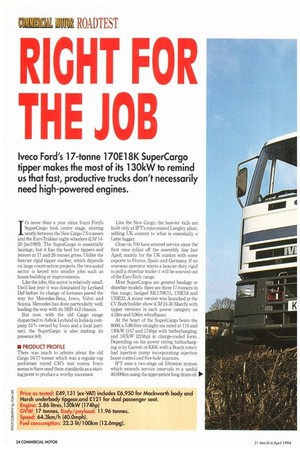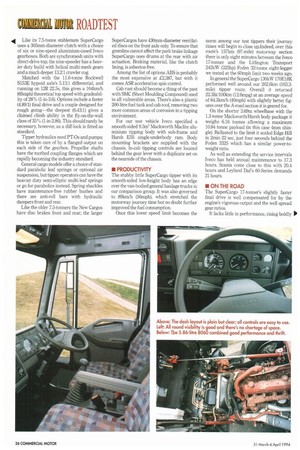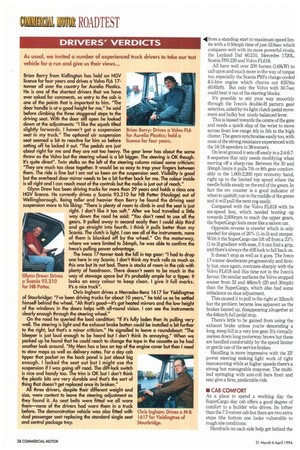RIGHT FOR THE JOB
Page 28

Page 30

Page 32

Page 33

If you've noticed an error in this article please click here to report it so we can fix it.
It's more than a year since Iveco Ford's SuperCargo took centre stage, slotting neatly between the New Cargo 7.5-tonners and the EuroTrakker eight-wheelers (CM 1420 Jan1993). The SuperCargo is essentially haulage, but it has the beef for tippers and mixers at 17 and 26 tonnes gross. Unlike the heavier rigid tipper market, which depends on large construction projects, the two-axled sector is keyed into smaller jobs such as house building or improvements.
Like the jobs, this sector is relatively small. Until last year it was dominated by Leyland Daf before its change of fortunes paved the way for Mercedes-Benz, Iveco, Volvo and Scania. Mercedes has done particularly well; leading the way with its 1820 4x2 chassis.
But now, with the old Cargo range dispatched to Ashok Leyland in India (a company 51% owned by Iveco and a local partner), the SuperCargo is also making its presence felt.
• PRODUCT PROFILE
There was much to admire about the old Cargo 16/17-tonner which was a regular top performer round CM'S test routes. Iveco seems to have used these standards as a starting point to produce a worthy successor. Like the New Cargo, the heavier 4x2s are built only at EFT's rejuvenated Langley plant, adding UK content to what is essentially a Latin lugger, Close on 700 have entered service since the first ones rolled off the assembly line last April; mainly for the UK market with some exports to France, Spain and Germany. If an overseas operator wants a heavier duty rigid to pull a drawbar trailer it will be sourced out of the EuroTech range.
Most Supereargos are general haulage or drawbar models: there are three 17-tonners in this range, badged ML170E15, 170E18 and 170E23. A mixer version was launched at the CV Bodybuilder show (CM 24-30March) with tipper versions in each power category on 4.18m and 3.96m wheelbases.
At the heart of the SuperCargo beats the 8060; a 5.86-litre straight-six rated at 110 and 130kW (147 and 174hp) with turbocharging, and 167kW (224hp) in charge-cooled form. Depending on the power rating turbocharging is by Garrett or KKK with a Bosch rotary fuel injection pump incorporating injection boost control and five-hole injectors.
IFT uses a two-stage oil filtration system which extends service intervals to a useful 40,000km using the appropriate long drain oil. 111' .4 Like its 7.5-tonne stablemate SuperCargo uses a 305mm-diameter clutch with a choice of six or nine-speed aluminium-cased Iveco gearboxes. Both are synchromesh units with direct-drive top; the nine-speeder has a heavier duty build with helical multi-mesh gears and a much deeper 13.2:1 crawler cog.
Matched with the 1L6-tonne Rockwell S153E hypoid axle's 5.13:1 differential, and running on 12R 22.5s, this gives a 104km/h (65mph) theoretical top speed with gradeability of 28% (1-in-3.6). Options include a faster (4.89:1) final drive and a couple designed for rough going—the deepest (6A3:1) gives a claimed climb ability in the fly-on-the-wall class of 35% (1-in-2.86). This should rarely be necessary, however, as a diff-lock is fitted as standard.
Tipper hydraulics need PT-Os and pumps; this is taken care of by a flanged output on each side of the gearbox. Propeller shafts have the toothed coupling flanges which are rapidly becoming the industry standard.
General cargo models offer a choice of standard parabolic leaf springs or optional air suspension, but tipper operators can have the heavier duty semi-elliptic multi-leaf springs or go for parabolics instead. Spring shackles have maintenance-free rubber bushes and there are anti-roll bars with hydraulic dampers front and rear.
Like the older 7.5-tonners the New Cargos have disc brakes front and rear; the larger SuperCargos have 430mm-diameter ventilated discs on the front axle only. To ensure that gremlins cannot affect the park brake linkage SuperCargo uses drums at the rear with air actuation. Braking material, like the clutch lining, is asbestos-free.
Among the list of options ABS is probably the most expensive at £2,387, but with it comes ASR acceleration spin control.
Cab rust should become a thing of the past with SMC (Sheet Moulding Compound) used in all vulnerable areas, There's also a plastic 200-litre fuel tank and cab roof, removing two more common areas of corrosion in a tipping environment.
For our test vehicle Iveco specified a smooth-sided 9.3m3 Mackworth Maclite aluminium tipping body with sub-frame and Harsh E55 single-underbody ram. Body mounting brackets are supplied with the chassis. In-cab tipping controls are located behind the gear lever with a duplicate set on the nearside of the chassis.
• PRODUCTIVITY The stubby little SuperCargo tipper with its smooth-sided low-height body has an edge over the van-bodied general haulage trucks in our comparison group. It was also governed to 891cm/h (56mph), which stretched the motorway journey time but no doubt further improved the fuel consumption.
Once this lower speed limit becomes the norm among our test tippers their journey times will begin to close up.Indeed, over this route's 1571cm (97-mile) motorway section there is only eight minutes between the Iveco 17-tonner and the Litlington Transport 242kW (325hp) Foden 32-tonne eight-legger we tested at the 60mph limit two weeks ago.
In general the SuperCargo 130kW 170E18K performed well around our 262.6km (163.2mile) tipper route. Overall it returned 22.31it/100km (12.6mpg) at an average speed of 64,3km/h (40mph) with slightly better figures over the A-road section it is geared for.
On the shorter 3.69m wheelbase with the 1.3-tonne Mackworth/Harsh body package it weighs 6.16 tonnes allowing a maximum 10.84 tonne payload (in this case 4mm shingle). Ballasted to the limit it scaled Edge Hill in 2min 22 sec, just four seconds behind the Foden 3325 which has a similar power-toweight ratio.
As well as extending the service intervals Iveco has held annual maintenance to 17.3 hours. Scania come close to this with 204 hours and Leyland Daf's 60-Series demands 21 hours.
• ON THE ROAD The SuperCargo 17-tonners slightly faster final drive is well compensated for by the engine's vigorous output and the well spread gear ratios.
It lacks little in performance, rising boldly from a standing start to maximum speed limits with a 0-50mph time of just 52.6sec which compares well with its more powerful rivals, the Leyland Daf 60.210, Mercedes 1720L, Scania P93-220 and Volvo FL618.
All have well over 200 horses (149kW) to call upon and much more in the way of torque too, especially the Scania P93's charge-cooled 8.5-litre engine which churns out 835Nm (6161b1t). But only the Volvo with 50.7sec could beat it out of the starting blocks.
It's possible to stir your way smoothly through the Iveco's double-H pattern gear selection, aided by its light clutch pedal movement and bulky but nicely balanced lever.
This is biased towards the centre of the gate and needs a quick slap of the wrist to move across from low-range 4th to 5th in the high cluster. The gears synchronise easily too, with none of the strong resistance experienced with the 16/18-speeders in 38-tonners.
On level ground it sets off easily in a 2-4-6-78 sequence that only needs modifying when moving off a sharp rise. Between the 30 and 50mph limits it pulls 7th or 8th gear comfortably in the 1,600-2,200 rpm economy band, right up to the limited top speed where the needle holds steady on the end of the green. In fact the rev counter is a good indicator of when to upshift run to the middle of the green and it will pull the next cog easily.
Compared with the Volvo FL618 with its six-speed box, which needed booting up towards 2,600rpm to reach the upper gears, the SuperCargo feels more like a saloon car.
Opposite reverse is crawler which is only needed for slopes of 20% (1-in-5) and steeper. With it the SuperCargo can lift off from a 33% (1-in-3) gradient with ease, if it can find a grip, and there's always the cliff-lock to fall back on.
It doesn't stop as well as it goes. The Iveco 17-tonner decelerates progressively and firmly but, once again, contrasts sharply with the Volvo FL618 and this time not in the Iveco's favour. On similar surfaces the Volvo stopped sooner from 32 and 481cm/h (20 and 30mph) than the SuperCargo, which also had some imbalance on shoe adjustment.
This caused it to pull to the right at 321un/h but the problem became less apparent as the brakes heated up, disappearing altogether at the 6411cm/h full pedal stop.
There's little to be gained from using the exhaust brake unless you're descending a long, steep hill in a very low gear. It's virtually useless down long motorway brows but these are handled comfortably by the speed limiter or gentle use of the service brakes.
Handling is more impressive with the ZF power steering making light work of tight manoeuvring while at higher speeds there's a strong but manageable response. The multileaf springing with anti-roll bars front and rear give a firm, predictable ride.
• CAB COMFORT
As a place to spend a working day the SuperCargo day cab offers a good degree of comfort to a builder who drives. Its loftier than the 7.5-tonner cab but there are two extra steps (the bottom one looks vulnerable to rough site conditions.
Handrails on each side help get behind the
wheel, which is adjustable for rake but not height. The air-suspended drivers seat also adjusts for comfort and has seat belts that are integral with the backrest, Seat trim is a warm chequered cloth but the haulage model's fabric door panels are replaced by vinyl; rubber covers the floor and engine cowl. Our test truck had an optional twin passenger seat; without it the cab centre would be spacious with a long storage pocket on the back wall.
The roof vent is not fitted to tipping models which leaves acres of headroom; there's a central header section with pockets and the radio. The shallow glove box has a back panel that pulls down to reveal the fuses and relays and a limited amount of gear can be stowed under and behind the seats too.
The cab heater works quickly and efficiently and the insulation helps to maintain temperatures, but loses its sound deadening qualities at speeds over 80km/h. At the limited speed decibels rise to 76.5 ciB(A), but
nowhere as high as the 86dB(A) of the Iveco 7.5-tonner cab at 60mph.
Visibility is good with large windows, especially on the rear wall. Rearview mirrors are a good size and the small kerb mirror is also useful.
The flat instrument panel is unexciting but the instrumentation is clear and nicely backlit in green for nightime use. Controls are well positioned as are the three stalk switches on the column; one on the right, two on the left.
• SUMMARY
Iveco has obviously given the same amount of attention to tipper chassis as it has to the rest of its 17-tonne range. As its performance shows it makes more sense to specify the 130kW engine and eight-speed gearbox than to simply follow the headlong rush towards high horsepower.
Your average jobbing builder will be more than happy with this little tipper to keep the his gangs supplied with material. At £42,060
it's expensive compared with other tipper chassis, particularly Scania's 162kW (217hp) tipper chassis which is a steal at £37,500, and contract maintenance costs nearly twice as much as the P93 over five years. Against that its parts prices are lower and there's less annual downtime.
The 130kW SuperCargo bustles along nicely, is economical and hauls a commendable 10.8-tonne payload. The front cab corner looks a little low and may get damaged on site work but its inner sanctum is quite comfortable and is easy to drive and clean out by a tradesman/driver. It handles easily and can thread its way around tight obstacles with only minimal shunting.
The 170E18K has a lower UK content than its predecessor and there's no longer a blue dimple on the grill. But this SuperCargo has many of the old Cargo's virtues and a few more besides: perhaps it's time for Ford devotees to put aside their reservations.






























































































